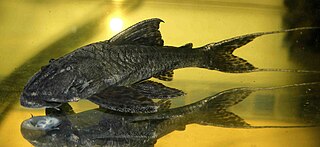
The Amazon basin is the part of South America drained by the Amazon River and its tributaries. The Amazon drainage basin covers an area of about 6,300,000 km2 (2,400,000 sq mi), or about 35.5 percent of the South American continent. It is located in the countries of Bolivia, Brazil, Colombia, Ecuador, Guyana, Peru, Suriname, and Venezuela.

Plecostomus, pleco, or plec is the common name of several species of freshwater loricariid catfish commonly sold as aquarium fish.

Acanthicus is a genus of large, South American suckermouth armored catfishes native to the Amazon and Orinoco basins, and possibly in Guyana. The name Acanthicus is derived from the Greek, akanthikos meaning thorny, spiny. Fish of this genus are known as lyre-tail plecos. These species are found in large rivers, primarily in areas with a rocky bottom and a moderate or strong current.

The Hypostominae are a subfamily of catfishes of the family Loricariidae. Most members of the subfamily are restricted to tropical and subtropical South America, but there are also several species in southern Central America. Hypostomus plecostomus, which is popular in the aquarium trade, has been introduced to several regions far from its native range.

Acanthicus hystrix, the lyre-tail pleco, is a species of armored catfish native to the Amazon, Tocantins–Araguaia and Orinoco basins. It is typically found at various depths on a rock or rock–gravel bottom in the main channel of rivers in places with moderate to strong current, although it also occurs in slow currents. The species is occasionally seen in the aquarium trade, but its adult size and territorially aggressive behavior means that a very large tank is required.

Panaqolus is a genus of small catfish in the family Loricariidae native to rivers in tropical South America.

Peckoltia vittata is a species of catfish belonging to the subfamily Hypostominae of family Loricariidae. This species possesses the L-number L015
Panaque bathyphilus is an Amazonian species of armoured catfish from the family Loricariidae. The holotype of the species was collected in the Solimões river, upstream of its confluence with the Purus river. This species has been known in the aquarium trade, at least since 1992, as papa panaque and under the L-number code L090. It reaches up to about 40 cm (16 in) in length.

Peckoltia pankimpuju is a species of armored catfish from the family Loricariidae, native to the Marañón River in the upper Amazon basin of Peru. It is commonly called the coal pleco, Peruvian lyre-tail, and L350 under the L-number code. It reaches up to about 40 cm (16 in) in length.
Panaqolus nocturnus, known as the dusky panaque, is a species of small catfish in the family Loricariidae found in the Santiago and Pastaza River basins in the upper Napo drainage in tropical South America. This species reaches a maximum standard length of 14.4 cm (5.7 in).
Ancistrus maximus is a species of catfish in the family Loricariidae. It is native to South America, where it occurs in the Branco River basin in Roraima, Brazil. The species is notable among members of Ancistrus for its comparatively large size, reaching 20.1 cm SL, a characteristic which is also the source of its specific epithet.
Chaetostoma changae is a species of catfish in the family Loricariidae. It is native to South America, where it is known only from Peru. The species reaches 7.6 cm SL and its specific epithet honors Fonchii Chang, a Peruvian ichthyologist of the National University of San Marcos.
Chaetostoma joropo is a species of catfish in the family Loricariidae. It is native to South America, where it occurs in the Cusiana River basin in the Orinoco drainage in Colombia. The species reaches at least 12.47 cm SL and was described in 2016 by Gustavo A. Ballen of the University of London, as well as Alexander Urbano-Bonilla and Javier A. Maldonado-Ocampo of the Pontifical Xavierian University. It appears in the aquarium trade, where it is frequently referred to by its L-number, which is L-445. This species has reportedly been known to aquarists for quite some time prior to its 2016 scientific description.
Chaetostoma platyrhynchus is a species of catfish in the family Loricariidae. It is native to South America, where it occurs in the Caquetá River basin in Colombia. The species reaches 9.5 cm in total length. The species is known to be of disputed classification and spelling.

Hypancistrus margaritatus is a species of catfish in the family Loricariidae. It is native to South America, where it occurs in the Takutu River of Guyana, which is a tributary of the Branco River, which is in turn a tributary of the Rio Negro in the Amazon basin. The species reaches 4.6 cm SL. Its specific epithet means "adorned with pearls" in Latin, referring to its distinctive pearl-like white spots. It was described in 2016 by Milton Tan and Jonathan W. Armbruster on the basis of coloration, alongside the related species Hypancistrus phantasma.

Panaqolus albivermis is a species of catfish in the family Loricariidae. It is native to South America, where it occurs in the San Alejandro River, which is a tributary of the Ucayali River in Peru. The species reaches 9.6 cm SL.
Panaqolus albomaculatus is a species of catfish in the family Loricariidae. It is native to South America, where it occurs in the headwaters of the Napo River, the Marañón River, and the Ucayali River. The species reaches 12.4 cm SL. It is sometimes seen in the aquarium trade, where it is typically referred to either as the mustard-spot pleco, the orange-spot pleco, or by its L-number, which is LDA-031.
Panaqolus changae is a species of catfish in the family Loricariidae. It is native to South America, where it occurs in the basins of the Itaya River and the Momón River in Peru. The species reaches 8.5 cm SL and its specific epithet honors Fonchii Chang, a Peruvian ichthyologist of the National University of San Marcos. It appears in the aquarium trade, where it is referred to either as the Iquitos tiger pleco, referencing the fact that the species is known to occur near the city of Iquitos, or by its L-number, which is L-226.
Panaqolus dentex is a species of catfish in the family Loricariidae. It is native to South America, where it occurs in the basins of the Napo River, the Pastaza River, and the Marañón River. The species reaches 8 cm SL.
Panaqolus gnomus, sometimes known as the dwarf panaque, is a species of catfish in the family Loricariidae. It is a freshwater fish native to South America, where it occurs in the basins of the Pastaza River and the Marañón River. The species reaches 7.1 cm SL. It is the type species of the genus Panaqolus, which was historically considered to be a clade of small-sized species within the genus Panaque, hence the common name of this species.








